Since my last post on simplifying a complex scene, I have had several readers ask about my plein air painting setup. So, in case anyone else is curious, I have put together this post about what I have in my setup and why I have it. I cover:
- Requirements of the Plein Air Setup
- Summary of What Is Included
- Pochade Box
- Brushes
- Canvas
- Paints
- Solvent
- Other Accessories
- What I Need
- Using This Setup
- Want to Learn More?
- Thanks for Reading!
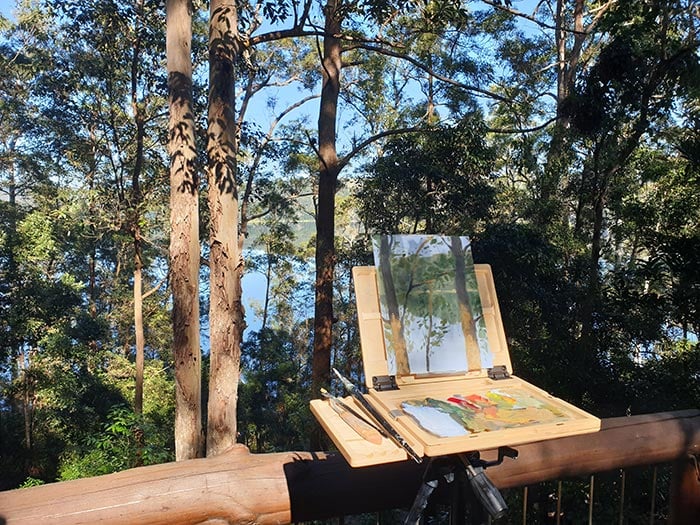
(Before diving into this post, make sure to pick up a copy of my free Landscape Painting Starter Kit.)
Requirements of the Plein Air Setup
I had several requirements when putting together this setup:
- It needs to be portable and able to fit within a hiking backpack, without compromising too many of the studio benefits;
- It needs to be lightweight;
- It needs to be easy to clean and pack up; and
- It needs to be environmentally friendly (I want to leave the environment as it was before I painted there).
Summary of What Is Included
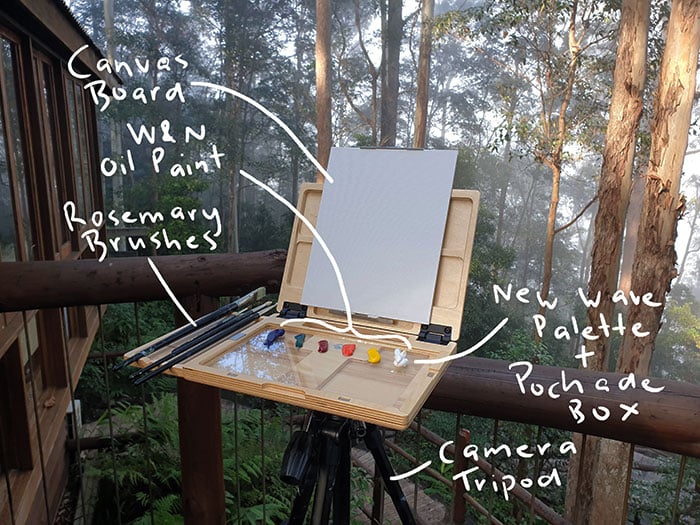
Here is a summary of everything included in my plein air painting setup:
- New Wave pochade box with a clear glass palette;
- Side tray which attaches to the pochade box and holds my brushes;
- Cinch and carabiner sets for securing accessories to the pochade box;
- Camera tripod for holding the pochade box;
- A variety of Rosemary & Co brushes (flats, rounds, and liner brushes);
- Canvas boards/panels;
- Oil paints by Winsor & Newton (colors are discussed later in the post);
- Odorless solvent;
- Paper towel (for wiping my brush between strokes and general cleanup);
- Plastic bags (for cleanup and holding brushes and paints); and
- An old mug for holding solvent.
All this (excluding the camera tripod) fits conveniently within a small hiking backpack.
Pochade Box
The pochade box is 8.4″ x 11.25″ and sold by New Wave. To go with this, I also purchased:
- A clear glass palette (the pochade box does not come with a palette);
- Anywhere side tray (for holding brushes); and
- Cinch and carabiner sets (for securing accessories to the pochade box).
The pochade box is made to conveniently attach to a camera tripod (the tripod does not come with the purchase).
Brushes
For the brushes, I lean towards the larger sizes because I need to paint quickly and efficiently. I use a handful of different flats, rounds, and a small liner brush for detailing. The brand I use is Rosemary & Co, which I highly recommend if your budget allows.
Whilst I am painting, I can rest the brushes on the side tray which you can purchase with the pochade box. But just be aware the side tray only holds a handful of brushes, so you will need to limit your selection.
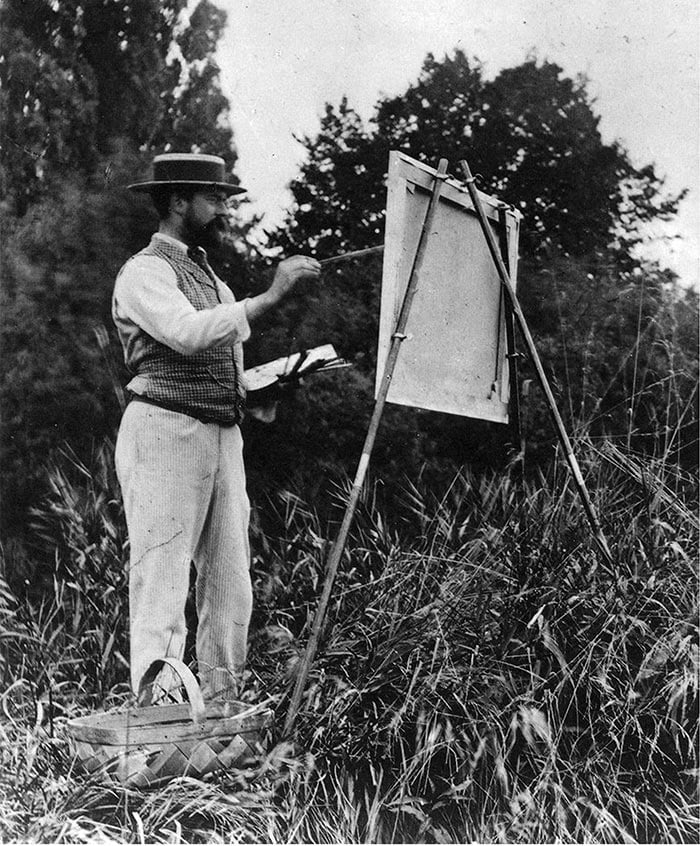
Canvas
I paint on small canvas boards by Mont Marte. These are cheap, portable, and sturdy. I stay away from stretched canvas, as it tends to be less portable and more fragile.
Depending on the size, the canvas boards can be kept in the hiking backpack. However, you will need to consider how to get the painting back to the studio once you are finished painting. I go into more detail on this in the “What I Need” section at the end of the post.
Paints
I use Winsor & Newton artist quality oil paints in the following colors:
- Ultramarine blue
- Viridian green
- Permanent alizarin crimson
- Cadmium red
- Cadmium yellow
- Titanium white
This is a fairly limited palette, which is ideal for painting plein air. The fewer colors you have on your palette, the easier it is to manage.
The main compromise of a limited palette is being unable to mix certain colors which you might need. But you could always change the colors on your palette if you know in advance what you are going to paint. For example, if you are going to paint a scene with bright, orange flowers, then you might want to include a cadmium orange on your palette for that occasion.
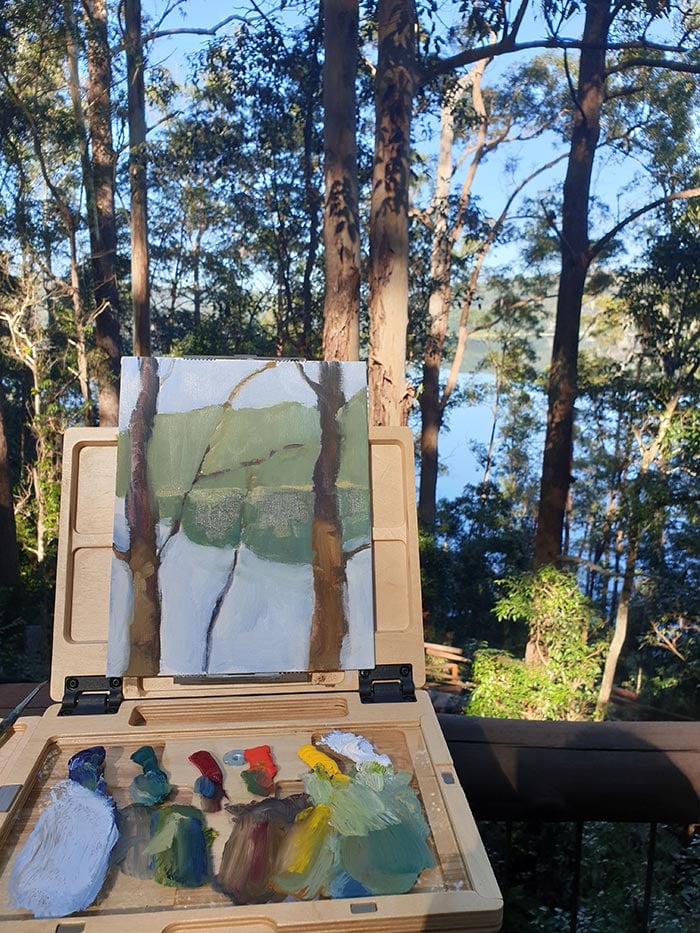
Solvent
Since I paint with oils, I use odorless solvent to add some fluidity to the paint and also for cleaning. I do not use any other medium (like linseed oil).
If you are painting with acrylics, watercolors or gouache, then you can just use water as your solvent to add fluidity to the paint.
Other Accessories
Here are the other accessories I use:
- Paper towels (for wiping down my brush between strokes and for general clean up);
- Plastic bags (for storing waste); and
- Cups and other containers (for holding solvent and storing waste).
What I Need
Next on my purchase list is a wet canvas carrier to transport paintings back to the studio. Something like this.
An umbrella would also be handy for painting under the sun and for controlling light.
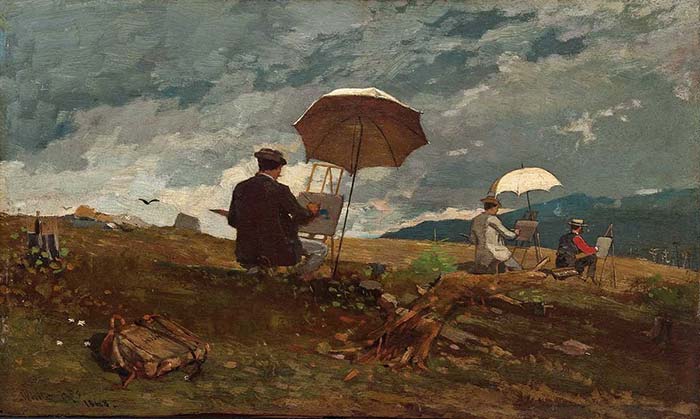
Using This Setup
Here are some general tips for using this setup:
- Place a large, plastic bag between the legs of the tripod. You can use this as a portable bin for paper towels or other rubbish.
- Use thinned paint to quickly sketch and block-in the composition. You want to capture your initial impression of the scene before the environment changes too much.
- Use larger brushes, as they allow you to paint faster and more efficiently.
- The pochade box which I purchased does not allow for large canvas sizes. If you want to create large-scale paintings on location, then you might want to consider something more sturdy, like a French easel.
- If you are oil painting like me, then make sure you take all your waste away with you. Bring containers for any solvent or medium and plastic bags for any paper towels and excess paint.
Want to Learn More?
You might be interested in my Painting Academy course. I’ll walk you through the time-tested fundamentals of painting. It’s perfect for absolute beginner to intermediate painters.
Thanks for Reading!
I appreciate you taking the time to read this post and I hope you found it helpful. Feel free to share it with friends.
Happy painting!
Dan Scott

Draw Paint Academy

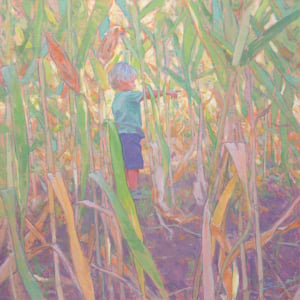
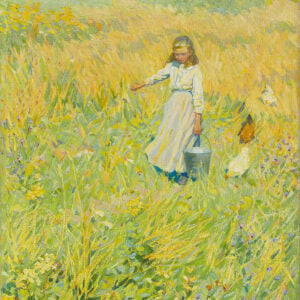
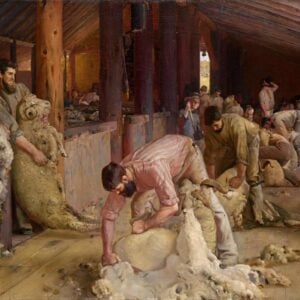

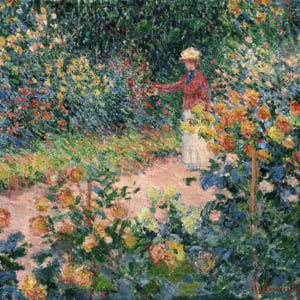
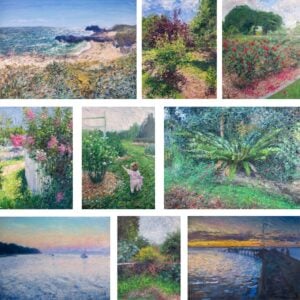
Thanks for sharing this information. I haven’t tried to paint en pllein aire but you make it look enticing. I also appreciate the fact that you named the brands like you like to use.
Thanks
Not sure what palette the author is using. Looks like a homemade glass. Best to use the New Wave medium gray glass palette,which makes it easier to see the color and value while mixing. It’s just an accessory when you order the pochade box.
Thank you Dan. Very helpful.
Thank you! I’ve been joining a local art group once a month to Plein air paint beautiful places where we live; cherry blossoms, farms, gardens, and Harbors. I use acrylic, which is a disadvantage- as it dries so quickly. I plan on beginning oils. My question is how do you avoid muddy colors? I typically begin back to front with acrylic, but it seems if I do that with oil I’ll have s muddy mess. Any advice for beginners in oil?
There is retarder medium and open golden acrylics thatbeillnhelntgem drying so fast
If you like acrylics, try Golden open acrylics. They dry slowly and are ideal for plein aire. It may be easier and cheaper than going with oils, especially if you have not worked with oils before.
Thank u Dan!
Your tips are really helpful. I have always wanted to try plein air, as it is really growing in popularity in my part of the country (Shasta County, California). There are so many beautiful, natural wonders to paint here.
Always Inspired,
Janet M
Thank you so much dear Dan, this is so nice , beacuse past two weeks I was in Rovinj, small town
In the Istra and see some beautiful scene whic I shoot with my photo-aparat and as I live deep in
forest ,nature and open space for my painting is exelent for me with this your informations.
Thank you so much.
what do you guys do with all the paint left on the pallett
The palette slides out, and you can put it in the freezer. It saves it for about a week or two.
I turn my pallet upside down and smear it around on a blank canvas. Makes an interesting start for another painting…
I use the rest of the colors for the smaller picture, because with one canvas I always have the other smaller one
Thank you so much Dan this was very helpful!
Eish Dan! You make it sound so easy. But for long-in-the-tooth ladies like me, it feels like “work”, which is a 4-letter word that one hesitantly whispers lest someone should hear.
But one day l’ll try it. Only there are not so many days left…!
Dan, thanks for these tips. I tried plein air painting and it was a failure. I’m encouraged by your advice, enough so that I want to try it again, only organizing my setup better. Using an umbrella was especially helpful because it was the direct sunlight that gave me a lot of problems. What do you do with the dirty odorless solvent?
Hi Sue. Yes I would urge you to try again. Can only get better! I put the leftover solvent in a container and take it back home to the studio.
Very nice, Dan! Your side tray looks much sturdier than the one I have! I’m using my dad’s set up which he got from Open Box M in Cody Wyoming USA. My dad passed in 2009 and left me his painting things. My biggest trouble with this outfit is that it is hard for me to get the canvas board fastened tightly on the box!! Thank you for all your info!
Hi, teacher ! There are so many natural wonders around me. How to simplify them and express in painting my real feelings properly ? I think I lack abstract jugement, anyway your tips are very very useful.Thank you very much.